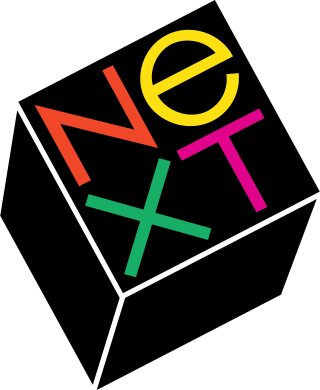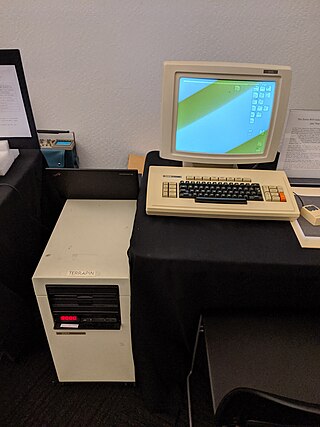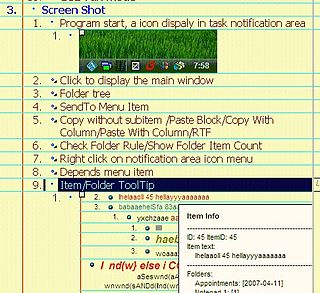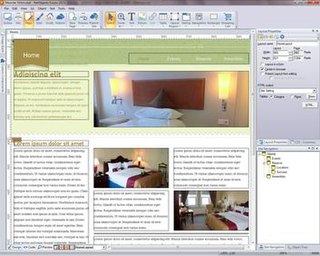Related Research Articles

NeXT, Inc. was an American technology company headquartered in Redwood City, California that specialized in computer workstations for higher education and business markets, and later developed web software. It was founded in 1985 by CEO Steve Jobs, the Apple Computer co-founder who had been forcibly removed from Apple that year. NeXT debuted with the NeXT Computer in 1988, and released the NeXTcube and smaller NeXTstation in 1990. The series had relatively limited sales, with only about 50,000 total units shipped. Nevertheless, the object-oriented programming and graphical user interface were highly influential trendsetters of computer innovation.

Lisa is a desktop computer developed by Apple, produced from January 19, 1983 to August 1, 1986, and succeeded by Macintosh. It is generally considered the first mass-market personal computer operable through a graphical user interface (GUI). In 1983, a machine like the Lisa was still so expensive that it was primarily marketed to individual and small and medium-sized businesses as a groundbreaking new alternative to much bigger and more expensive mainframes or minicomputers such as from IBM, that either require additional, expensive consultancy from the supplier, hiring specially trained personnel, or at least, a much steeper learning curve to maintain and operate. Earlier GUI-controlled personal computers were not mass-marketed; for example, Xerox PARC manufactured its Alto workstation only for Xerox and select partners from the early to mid-1970s.

The Xerox Star workstation, officially named Xerox 8010 Information System, is the first commercial personal computer to incorporate technologies that have since become standard in personal computers, including a bitmapped display, a window-based graphical user interface, icons, folders, mouse (two-button), Ethernet networking, file servers, print servers, and email.

Taligent Inc. was an American software company. Based on the Pink object-oriented operating system conceived by Apple in 1988, Taligent Inc. was incorporated as an Apple/IBM partnership in 1992, and was dissolved into IBM in 1998.
A personal information manager is a type of application software that functions as a personal organizer. The acronym PIM is now, more commonly, used in reference to personal information management as a field of study. As an information management tool, a PIM tool's purpose is to facilitate the recording, tracking, and management of certain types of "personal information".

OpenDoc is a defunct multi-platform software componentry framework standard created by Apple in the 1990s for compound documents, intended as an alternative to Microsoft's proprietary Object Linking and Embedding (OLE). It is one of Apple's earliest experiments with open standards and collaborative development methods with other companies. OpenDoc development was transferred to the non-profit Component Integration Laboratories, Inc., owned by a growing team of major corporate backers and effectively starting an industry consortium. In 1992, the AIM alliance was launched by Apple, IBM, and Motorola, with OpenDoc as a foundation. With the return of Steve Jobs to Apple, OpenDoc was discontinued in March 1997.

A/UX is a Unix-based operating system from Apple Computer for Macintosh computers, integrated with System 7's graphical interface and application compatibility. It is Apple's first official Unix-based operating system, launched in 1988 and discontinued in 1995 with version 3.1.1. A/UX requires select 68k-based Macintosh models with an FPU and a paged memory management unit (PMMU), including the Macintosh II, SE/30, Quadra, and Centris series.

eWorld was an online service operated by Apple Inc. between June 1994 and March 1996. The services included email, news, software installs and a bulletin board system. Users of eWorld were often referred to as "ePeople."

Kaleida Labs, Inc., formed in 1991 to produce the multimedia cross-platform Kaleida Media Player and the object oriented scripting language ScriptX that was used to program its behavior. The system was aimed at the production of interactive CD ROM titles, an area of major effort in the early 1990s. When the system was delivered in 1994, it had relatively high system requirements and memory footprint, and lacked a native PowerPC version on the Mac platform. Around the same time, rapid changes in the market, especially the expansion of the World Wide Web and the Java programming language, pushed the interactive CD market into a niche role. The Kaleida platform failed to gain significant traction and the company was closed in 1996.

The Power Macintosh 6100 is a personal computer designed, manufactured and sold by Apple Computer from March 1994 to March 1996. It is the first computer from Apple to use the new PowerPC processor created by IBM and Motorola. The low-profile ("pizza-box") case was inherited from the Centris/Quadra 610 and 660AV models, and replaced the Macintosh Quadra series that used the Motorola 68040 processor, Apple's previous high-end workstation line.

Now Software was the producer of Now Up-to-Date & Contact, a calendaring software and contact manager for individuals and groups, for macOS and Windows. The company was incorporated in 1989.

Ecco Pro is a personal information manager software based on an outliner, and supporting folders similar to spreadsheet columns that allow filtering and sorting of information based upon user defined criteria.
The Macintosh LC 500 series is a series of personal computers that were a part of Apple Computer's Macintosh LC family of Macintosh computers, designed as a successor to the compact Macintosh family of computers for the mid-1990s mainstream education-market. The all-in-one desktop case is similar to the then recently introduced Macintosh Color Classic, but the LC 500 series is considerably larger and heavier due to its larger screen and a bulging midsection to house the larger electronics, including a 14" CRT display, CD-ROM drive, and stereo speakers.

Samir Arora is an Indian-American businessman and CEO of Sage Assist, a generative AI company, the former CEO or Kyro and founder of Sage Digital AI from 2016 to 2021, and the former CEO of Mode Media from 2003 to April 2016. He was CEO and chairman of the web design company NetObjects, Inc. from 1995 to 2001 and at Apple Inc. from 1982 to 1991. Arora was selected as one of the 21 Internet Pioneers that shaped the World Wide Web at the 1st Web Innovators Awards by CNET in 1997.

NetObjects, Inc. is a software company founded in 1995 by Samir Arora, David Kleinberg, Clement Mok and Sal Arora. The company is best known for the development of NetObjects Fusion, a web design application for small and medium enterprises with designers who need complete control over page layout and a similar user interface as desktop publishing applications.

NetObjectsFusion (NOF) is a web design tool, from 1996 to 2001 developed and distributed by NetObjects, Inc., marketed from 2001 until 2009 by Web.com, which bought the application in 2001, and from July 2009 on distributed again by the re-established NetObjects, Inc.
Rae Technology was a software company founded as a spin-off from Apple in 1992. Rae Technology was best known for its Personal Information Manager Rae Assist and for being the predecessor of NetObjects After transferring new developed technology for web site design to NetObjects in 1995, Rae Technology had no further public recognition.

The Newton is a series of personal digital assistants (PDAs) developed and marketed by Apple Computer, Inc. An early device in the PDA category, it was the first to feature handwriting recognition. Apple started developing the platform in 1987 and shipped the first devices starting August 2nd 1993. Production officially ended on February 27, 1998. Newton devices ran on a proprietary operating system, Newton OS; examples include Apple's MessagePad series and the eMate 300, and other companies also released devices running on Newton OS. Most Newton devices were based on the ARM 610 RISC processor and all featured handwriting-based input.
Mac operating systems were developed by Apple Inc. in a succession of two major series.
Modula-2 is a structured, procedural programming language developed between 1977 and 1985/8 by Niklaus Wirth at ETH Zurich. It was created as the language for the operating system and application software of the Lilith personal workstation. It was later used for programming outside the context of the Lilith.
References
- ↑ "Digital Media 24". The Hybrid Vigor Institute. Retrieved July 14, 2007.
- ↑ Gore, Andrew, Rae architecture goes Solo, MacWeek, May 31, 1993.
- 1 2 Tessler, Franklin N., Rae Assist 1.0.2. - Rae Technology's personal information management package, MacWorld, January 1, 1994.
- ↑ Rae Assist accelerated. MacWorld, April 1, 1994.
- ↑ PIM market abuzz with activity. MacWorld, September 1, 1995.
- ↑ CE Software in partnership with Rae Technology; collaboration will deliver workgroup personal information management products. Business Wire, January 16, 1995.